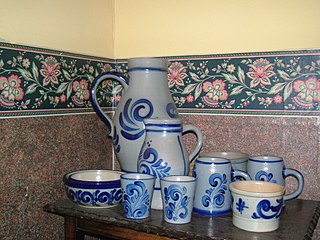 W
WA Bartmann jug, also called Bellarmine jug, is a type of decorated salt-glazed stoneware that was manufactured in Europe throughout the 16th and 17th centuries, especially in the Cologne region in what is today western Germany. The signature decorative detail was a bearded face mask appearing on the lower neck of the vessel. They were made as jugs, bottles and pitchers in various sizes and for a multitude of uses, including storage of food or drink, decanting wine and transporting goods.
 W
WJulius Dressler was a noted Bohemian ceramics manufacturing company that operated from the late 19th century until the end of World War II.
 W
WIn pottery hausmaler is a term for the artist, the style, and the pieces in hausmalerei, the process of buying pieces of pottery as plain "blanks", and then painting them in small workshops, or the homes of painters, before a final firing. In European pottery of the 17th to 19th centuries this was at certain times and places a significant part of production, and the decoration could be of very high quality.
 W
WHöhr-Grenzhausen is a town in the Westerwaldkreis in Rhineland-Palatinate, Germany. It is a centre for the ceramic industry in the Kannenbäckerland with a professional college for ceramics, another for ceramic form, and many others, hence the nickname Kannenbäckerstadt.
 W
WPingsdorf ware is a high fired earthenware, or proto-stoneware, that was produced between the late 9th and 13th century in different pottery centres on the Eastern margin of the Rhineland as well as the Lower Rhine region. Characteristic features of vessels in Pingsdorf ware are a yellow-coloured fine sand-tempered sherd and a red painting. It is archaeologically evident within various Medieval settlements of North Western Europe and thus represents an important chronological marker for the Medieval archaeology.
 W
WWest German Art Pottery is essentially a term describing the time period of 1949-1990 and became the early way to describe the pottery because the country of origin, with numbers denoting the shape and size, was often the only "mark" on the base. Even though company names are now better known, and many items are attributed to specific makers, the more generic term "West German pottery" remains in common use. "Fat Lava" is a popular term that strictly refers to a fairly small subcategory of glazes but is all too often improperly used as a synonym for West German pottery. West Germany began in 1949: World War II ended in 1945, the next 4 years were the "zone" era with the country into the "US Zone", "Russian/Soviet Zone", "British Zone", and "French Zone", and it was 1949 when the East/West division replaced the zones.
 W
WWesterwald Pottery or Stoneware is a distinctive type of salt glazed grey pottery from the Höhr-Grenzhausen and Ransbach-Baumbach area of Westerwaldkreis in Rheinland-Pfalz, Germany.